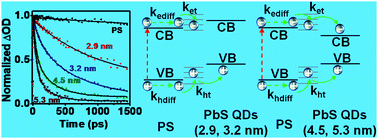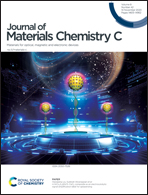Deciphering the role of quantum dot size in the ultrafast charge carrier dynamics at the perovskite–quantum dot interface†
Abstract
Deciphering the electron and hole (e, h) dynamics at the interfaces of photoexcited hybrid materials at different densities of photoexcited charge carriers is paramount to the development of efficient optoelectronic devices. Nanocomposites formed by methylammonium lead iodide perovskite (PS) and semiconductor colloidal quantum dots (QDs) are among these hybrid materials under intensive studies. However, the reciprocal influence of the components in the composite on the charge carriers’ dynamics is still poorly explored. Armed with femtosecond time-resolved techniques, we unravel the effect of PbS QD size, embedded in the PS matrix, on the e and h diffusion, transfer to the QD phase and recombination. While the decays are dominated by e and h transition from PS to QDs, the increase in the QD size results in an acceleration of the charge carriers’ transitions represented by the total transfer rate constants of electrons and holes. We extract the diffusion times and transfer rate constants to the interfaces. Furthermore, pumping with different fs-laser fluences indicates the photoformation of excitonic states, in which acceleration decreases the contribution of undesirable charge carrier trapping and non-radiative recombination within PS. Our results elucidate the importance of the QD size for improving the efficiency of LEDs based on these nanocomposites.



 Please wait while we load your content...
Please wait while we load your content...